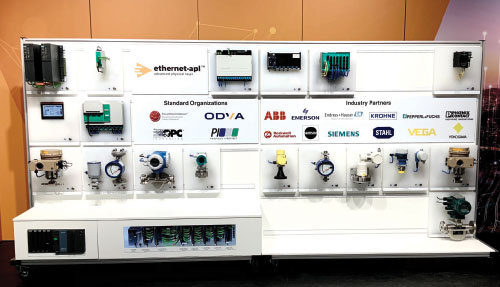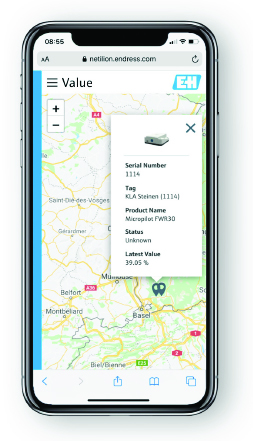Summary
Jump to:
- Open Integration, ‘Digital Chain’ May Solve IIoT Device Management Challenges
- ServiceNow Enters Industrial Sector with Digital Workflows
- Ethernet-APL is Closing the Industrial Digitalization Gap
- ISAGCA: Secure PLC Coding Best Practices Released
- PureCycle Plastics Recycling Plants Will Be ‘Born Digital’
- New Group to Further AI for Industrial Automation
- Endress+Hauser Unveils IIoT, Edge Innovations
Open Integration, ‘Digital Chain’ May Solve IIoT Device Management Challenges

The Open Integration Partner program, initiated by Endress+Hauser and now including 35 participating companies, seeks to improve the quality and efficiency of device integration and life-cycle maintenance of control and automation systems by focusing on simple, fast, and manufacturer-independent integration of components and devices into automation systems. The group held its first physical meeting in June 2019 at Endress+Hauser facilities in Reinach, Switzerland, then took a year off during the pandemic.
The Open Integration Partner Meeting occurred again—virtually this time—on 17 June 2021. The virtual event was an impressive follow-up to the first meeting, during which users made it clear that process control industry users want open, interoperable systems instead of proprietary solutions. The cooperation partners this year included Auma Riester, Bürkert, Festo, Flowserve, Hima Paul Hildebrandt, Honeywell Process Solutions, Mitsubishi Electric, Pepperl+Fuchs, Phoenix Contact, Rockwell Automation, Schneider Electric, Softing Industrial Automation, and Turck.
Vendors have their own data models for intelligent devices, asset management systems, and other software. The Open Integration initiative is focused on creating standard data models for devices to give users greater efficiency and productivity. This is analogous to what happened in the computer-aided design (CAD) market years ago, when each supplier had its own platform and data models for creating CAD drawings: Major users, particularly in the automotive industry, demanded standardization of the models. Eventually this drove the industry to open standards.
The meeting included a presentation by BASF on leveraging DIN SPEC 91406, the standard for automatic identification of physical objects and information on physical objects in information technology (IT) systems, particularly in IoT systems. DIN, the German Institute for Standardization, wrangles a consortium of asset owners and operators working on DIN SPEC 91406. Their goal is standardized identification of physical objects using 2D codes, such as QR codes, that mobile devices can read and that can be used to retrieve all relative information about a field device.
All information relating to the physical object can be identified in various IT systems, including assembly, maintenance, inspection, repair, and disassembly. Original equipment manufacturers (OEMs) can link all information, such as drawings, operating instructions, and spare parts lists to this ID, so users can quickly access all relevant information. Test, calibration, certification, and other documentation can also be electronically linked to digital records for each device.
Using these IDs, everyone can exchange information about a physical device throughout its life cycle, creating a digital chain of secure electronic access. This one-to-one ID is therefore the prerequisite for accessing and maintaining information in the physical object’s digital twin throughout its life cycle. This is particularly important for physical objects embedded in IIoT systems.
Industrial use cases for a digital chain of secure data can include on-site access to installation information or safety instructions for construction and operations and maintenance personnel, and access to repair instructions or spare parts lists for maintenance. Engineering can use digital chains to secure research of technical specifications on existing equipment, comparisons of OEM offerings, or downloads of 3D equipment surface models. —By Bill Lydon
ServiceNow Enters Industrial Sector with Digital Workflows
ServiceNow, a company that streamlines work processes with modern digital workflows, recently debuted its first product for the manufacturing and industrial sectors. The company’s workflow automation platform enables an enterprise to optimize business processes in any area, including logistics, customer service, employee hiring, or scientific discovery.
The company says customers have been asking for help to secure critical infrastructure. Abhijit Mitra, vice president and GM of industry products, said, “We are taking the IT expertise we have gained over the years and applying it to the manufacturing sector. We are applying our workflow platform [to] operational tech management.”
For its first product designed for the manufacturing sector, ServiceNow is partnering with Siemens Energy to help energy companies monitor, identify, and respond to cyberthreats. The solution combines AI-based software from Siemens’ Managed Detection and Response service with ServiceNow’s Operational Technology Management software to detect cyber anomalies and create a workflow to streamline their mitigation. —By Melissa Landon
Ethernet-APL is Closing the Industrial Digitalization Gap
Industrial networks have been using Ethernet for years. Now, work on the Advanced Physical Layer of Ethernet (Ethernet-APL) is accomplishing the goals of Industry 4.0 and industrial digitalization by closing the lingering communications gap between sensors/edge devices and business operations systems. The Ethernet-APL organization demonstrated the capabilities at the ACHEMA Pulse “Live Days” event in June. Organization members, including FieldComm Group, OPC Foundation, ODVA, and Profibus & Profinet International, showcased “IT-centric instrumentation” for process control, including hazardous areas.

The Ethernet-APL strategy achieves a common sensor and instrument physical and transport but does not converge and harmonize communication protocols, which remain separate and unique. Using universally accepted IT and IoT methods and frameworks, Ethernet-APL is connecting sensors to business systems in process plants using standard IEEE 802.3cg communications managed with IP—achieving high-speed, uniform, sensor information transfer via Ethernet.
The initiative uses the work of the IEEE 802.3cg task force, including amendments to the IEEE 802.3 Ethernet standard for an Ethernet physical layer operating at 10 Mb/s over single-pair cable with power delivery. Current and voltage will be limited to have an intrinsically safe solution for zones 0 & 1/Division 1. The APL project team has also cooperated with semiconductor manufacturers, who will offer 10BASE-T1L Phys for Ethernet-APL, enabling sensor manufacturers to support the standard. Just like standard Ethernet, this is a common transport for multiple protocol and messaging types.
The multivendor demonstration during ACHEMA Pulse illustrated interaction across different product vendors and networks, highlighting the multiple options and interoperability that Ethernet-APL will offer end users. The ACHEMA Working Ethernet-APL demonstration included: Rockwell, Siemens, and Emerson process controllers; ABB industrial PLCs; and ABB, Emerson, Endress+Hauser, and Siemens asset management software. The demonstration included 12 field instruments and devices from ABB, Emerson, Anderson Hauser, Krohne, Pepperl+Fuchs, Phoenix contact, Rockwell Automation, Sampson, Siemens, Stahl, Vega, and Yokogawa.
Ethernet-APL is the physical layer. Each individual standards organization will be responsible for its own conformance tests and Ethernet-APL certifications for devices supporting the protocol. Some of these registrations are expected to be defined and available by the end of the year. —By Bill LydonISAGCA: Secure PLC Coding Best Practices Released
The ISA Global Cybersecurity Alliance (ISAGCA), along with admeritia GmbH, announced that it is a contributing organization for the release of the “Top 20 Secure PLC Coding Practices.” This public-sourced document is the result of a grass-roots initiative to provide guidelines to control engineers for improving the security posture of industrial control systems (ICSs).

The “Top 20 PLC Coding Practices” document began with Jake Brodsky’s S4x20 session on tips and tricks he had learned in his long career with a water utility to improve the resiliency, maintenance, and security of programmable logic controllers and the underlying physical processes. PLCs, which were insecure when first designed, have been better secured over the years through the development of secure protocols, encrypted communications, network segmentation, and more. However, there has not been a focus on using the characteristic features in PLCs, supervisory control and data acquisition systems, or distributed control systems (DCS) for security, or much instruction on how to program PLCs with security in mind, he said.
Dale Peterson—ICS security consultant, speaker, podcaster, and founder of S4 Events—said Brodsky called out the fact that people programming and configuring PLCs are not being taught security practices. “It’s gratifying that the community, including organizations like ISAGCA, came together to fill this gap by creating and making freely available the ‘Top 20 PLC Secure Coding Practices,’ ” he said.
Little to no additional software tools or hardware are needed to implement these practices. Download the document and find links to informative videos at www.plc-security.com. —By Renee BassettPureCycle Plastics Recycling Plants Will Be ‘Born Digital’
PureCycle Technologies is planning a network of global facilities to enable large-scale recycling of a common but rarely recycled plastic. It is being supported by advanced digital technologies and automation from Emerson Automation Solutions. Emerson’s Plantweb digital ecosystem was chosen for the breadth of digital solutions, including intelligent sensors and control valves, advanced operations software and systems, cloud data management, and analytics.
“Unlike traditional manufacturing facilities coping with transforming legacy platforms to digital, PureCycle’s progressive approach will enable all future facilities to be born digital,” said Dustin Olson, chief manufacturing officer of PureCycle Technologies. “With Emerson’s help, each PureCycle facility is expected to start up with the most advanced digital automation technologies available, allowing for faster project completion, fully integrated systems, and world-class operating performance.”
Polypropylene, identified as resin recycling code #5, is one of the world’s most versatile plastics produced. It is widely used around the world for food and cosmetics packaging, toys, automobile parts, and more. Despite more than 170 billion pounds being produced each year, less than 1 percent is reclaimed annually for recycling and reuse.
“PureCycle’s first-of-its-kind technology purifies waste plastic to remove color, odor, and other contaminants to create a near-virgin ultrapure recycled polypropylene suitable for nearly any application,” Olson said.
PureCycle Technologies holds a global license to commercialize the only patented solvent-based purification recycling technology, developed by The Procter & Gamble Company. Early last year, machine builder Koch Modular was awarded the design and construction contract for the new plastics recycling plant. Koch Modular had been working with PureCycle for more than three years on the development of the technology. Koch Modular designed and constructed the predecessor Phase I Feedstock Evaluation Unit, which delivered successful production at scale in 2019. Koch’s contract included the supply of a complete raw-material-in-finished-product-out process system, modularly constructed, in a controlled indoor environment, that was then shipped to the plant site via roadway.—By Renee Bassett
New Group to Further AI for Industrial Automation
The Association for Advancing Automation (A3) has created a new artificial intelligence (AI) Technology Strategy Board of leading AI experts. It is part of a major initiative to promote education and adoption of the applications of artificial intelligence in automation industries. This new board places AI leadership at the same level as A3’s existing technology groups: robotics, vision & imaging, and motion control & motors.
Artificial intelligence is layering atop robotics, vision, motion control, and other automation technologies to create new solutions, great flexibility, and expanding opportunities. Big tech companies—once focused more on phones than factory floors—now view manufacturing, robotics, and industrial automation as key segments of their businesses.
The AI Technology Strategy Board will comprise senior executives from leading AI and technology companies. This is the first time the global trade association has added a technology group to its leadership since adding motion control in 2006. A3 represents 1,100 companies from across the automation industry. Companies such as Amazon, GE, Google, Intel, Microsoft, NVIDIA, and Siemens have helped guide A3’s initiatives.Endress+Hauser Unveils IIoT, Edge Innovations

A free smartphone app guides the user in capturing field instrument asset data using QR codes or RFID tags, storing images and instrument locations/accessibility, and saving other quality-relevant data. Netilion Analytics can be used to create a digital twin of the system, while Netilion Health tracks the condition of the instrument so that maintenance optimization measures can be initiated.
Netilion securely connects field devices, such as the new FieldEdge SGC500 gateway to the Internet, supporting HART, WirelessHART, and Profibus communication standards in combination with EtherNet/IP. The connection can be used to securely upload installed-base information and create lists of the instruments without requiring interaction with control systems. HTTPS data transfer with end-to-end encryption and authentication according to the OAuth 2.0 standard guarantees a highly secure connection, and data can only flow in one direction—from the field device to the Internet.
Reader Feedback
We want to hear from you! Please send us your comments and questions about this topic to InTechmagazine@isa.org.

